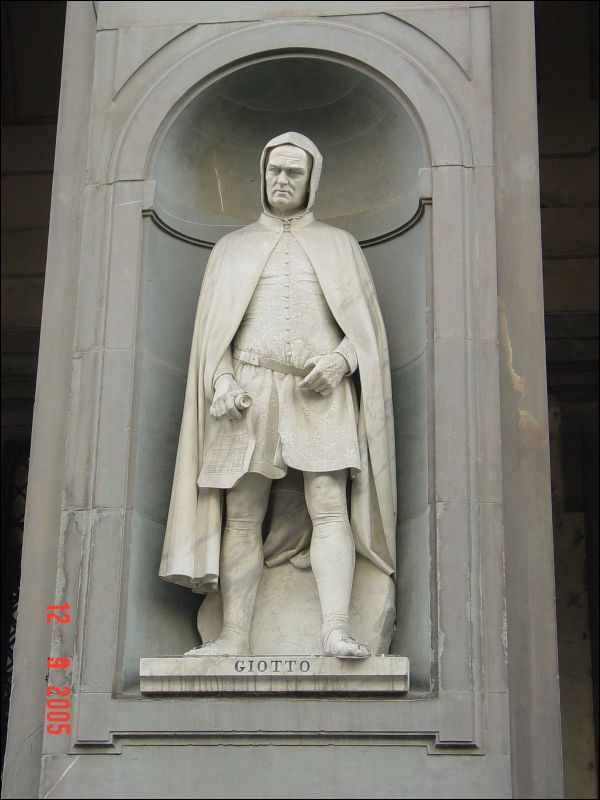Ark and Laura in Florence 2005 (120 of 172)
![[First]](bw_first.gif)
|
![[Prev]](bw_prev.gif)
|
![[Index]](bw_index.gif)
|
![[Next]](bw_next.gif)
|
![[Last]](bw_last.gif)
|

|
|
Giotto Giotto di Bondone, born about 1266 in the village of Vespignano, near Florence. Florentine painter and architect. Outstanding as a painter, sculptor, and architect, Giotto was recognized as the first genius of art in the Italian Renaissance. Giotto lived and worked at a time when people's minds and talents were first being freed from the shackles of medieval restraint. He dealt largely in the traditional religious subjects, but he gave these subjects an earthly, full-blooded life and force. His father was a small landed farmer. Giorgio Vasari, one of Giotto's first biographers, tells how Cimabue, a well-known Florentine painter, discovered Giotto's talents. Cimabue supposedly saw the 12-year-old boy sketching one of his father's sheep on a flat rock and was so impressed with his talent that he persuaded the father to let Giotto become his pupil. Another story is that Giotto, while apprenticed to a wool merchant in Florence, frequented Cimabue's studio so much that he was finally allowed to study painting. The earliest work attributed to Giotto is a series of frescoes on the life of St Francis in the church at Assisi. In about 1305 and 1306 Giotto painted the extraordinary series of frescoes in the Arena Chapel in Padua. Vasari tells the story of how Pope Boniface VIII sent a messenger to Giotto with a request for samples of his work. Giotto dipped his brush in red and with one continuous stroke painted a perfect circle. He then assured the messenger that the worth of this sample would be recognized. When the pope saw it, he "instantly perceived that Giotto surpassed all other painters of his time." In 1334 the city of Florence honored Giotto with the title of Magnus Magister (Great Master) and appointed him city architect and superintendent of public works. In this capacity he designed the famous Campanile (bell tower). He died in 1337, before the work was finished. In common with other artists of his day, Giotto lacked the technical knowledge of anatomy and perspective that later painters learned. Yet what he possessed was infinitely greater than the technical skill of the artists who followed him. He had a grasp of human emotion and of what was significant in human life. In concentrating on these essentials he created compelling pictures of people under stress, of people caught up in crises and soul-searching decisions. Giotto is regarded as the founder of the central tradition of Western painting because his work broke free from the stylizations of Byzantine art, introducing new ideals of naturalism and creating a convincing sense of pictorial space. His momentous achievement was recognized by his contemporaries (Dante praised him in a famous passage of The Divine Comedy, where he said he had surpassed his master Cimabue), and in about 1400 Cennino Cennini wrote 'Giotto translated the art of painting from Greek to Latin.' In the generation after his death he had an overwhelming influence on Florentine painting; it declined with the growth of International Gothic, but his work was later an inspiration to Masaccio, and even to Michelangelo. These two giants were his true spiritual heirs. [WebGallery of Art] |
![[First]](bw_first.gif)
|
![[Prev]](bw_prev.gif)
|
![[Index]](bw_index.gif)
|
![[Next]](bw_next.gif)
|
![[Last]](bw_last.gif)
|